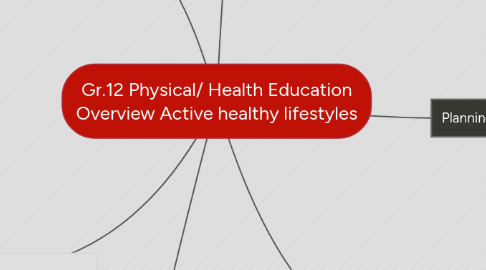
1. Implementation Overview
1.1. Lifelong physical activity participation: The intent of the Grades 11 and 12 curricula is to help students develop the necessary knowledge, skills, and attitudes in personal planning for lifelong physical activity participation.
1.2. Taking greater ownership: Due to the age and maturity of students in Grades 11 and12, the goal is to encourage students to take greater ownership for their physical fitness and to become involved in physical activities suited to their own individual interests and abilities.
1.3. Healthy decision making: Leading an active healthy lifestyle will contribute to health and well-being. Helping students underst and the importance of making informed healthy decisions relevant to the five major health risk areas for youth continues to be the focus in promoting active healthy lifestyles for all students.
1.4. Choice and variety: A key element for lifelong physical activity participation is finding activities that one personally enjoys and feels successful at. Where schools can offer students a choice and variety of activities within the IN-class component or the opportunity to choose their own activities as part of the OUT-of-class component, students are more likely to choose something that they enjoy and that would be suited to their interests and abilities.
1.5. Active and interactive learning strategies:Brain research (Cone, et al.; Jensen) supports the approach of engaging students in active learning to increase retention and to make learning more relevant, meaningful, and enjoyable. In a PE setting, learning/teaching strategies engage students through a variety of physical activities that involve many of the multiple intelligences (e.g., bodily/kinesthetic, visual, spatial). From an HEperspective, interactive learning/teaching strategies (e.g.,brainstorming, Think-Pair-Share, role playing) promote social interaction andcooperative learning, which highlight interpersonal intelligence.
1.6. Cooperative and low competitive-type learning activities:Cooperative and low competitive-type activities help promote positive social interactions among students,promote inclusion, and allow students to work together toward achieving a common goal. Competitive experiences that allow students to participate at or near their own ability level contribute to increasing self-confidence and make the games or challenges more enjoyable.
2. Planning for Instruction
2.1. Planning for Instruction Creating a Meaningful Learning Environment Implementation Guidelines for the General Learning Outcomes Planning for Students with Exceptional Learning Needs Fostering a Safe and Supportive Learning Environment for Potentially Sensitive Content Yearly/Semester Planning Unit Planning Lesson Planning Part B: Planning for Assessment Part C: Additional Planning
2.1.1. Project specifications
2.1.2. End User requirements
2.1.3. Action points sign-off
3. Notes
3.1. GLO 1—Movement The student will demonstrate competency in selected movement skills, and knowledge of movement development and physical activities with respect to different types of learning experiences, environments, and cultures.
3.2. GLO 2—Fitness Management The student will demonstrate the ability to develop and follow a personal fitness plan for lifelong physical activity and well-being.
3.3. GLO 3—Safety The student will demonstrate safe and responsi ble behaviours to manage risks and prevent injuries in physical activity participation and in daily living. level of risk of the activity level of instruction level of supervision facilities/environment equipment clothing/footwear environmental factors personal and other considerations
3.4. GLO 4—Personal and Social Management The student will demonstrate the ability to develop self-understanding, to make health-enhancing decisions, to work cooperatively and fairly with others, and to buildpositive relationships with others. goal-setting/planning skills decision-making/problem-solving skills interpersonal skills conflict-resolution skills stress-management skills
3.5. GLO 5—Healthy Lifestyle Practices The student will demonstrate the ability to make informed decisions for healthy living related to personal health practices, active living, healthy nutritional practices, substance use and abuse, and human sexuality.
3.6. goal-setting/planning skills decision-making/problem-solving skills interpersonal skills conflict-resolution skills stress-management skills
4. Framework overview
4.1. vision
4.1.1. PE,HE intergrated into 5 general learning outcomes.
4.1.1.1. aim
4.1.1.1.1. Social-emotional Well-being
4.1.1.1.2. Physical Well-being
5. Planning for Implementation
5.1. Guidelines for Implementation
5.1.1. Choose an implementation model
5.1.2. Develop an out of class safety model
5.1.3. Develop a pre- and post sign-off process
5.1.4. Establish evaluation and reporting procedures
6. Specific Learning Outcomes
6.1. The specific learning outcomes for Grade 12 curriculum are organized within five modules according to the three curriculum components:
6.1.1. The Flexible Delivery Component will address specific learning outcomes developed by the teacher and/or student.
6.1.2. The Core Component contains specific learning outcomes (for each of the four modules) focusing on health and personal development.
6.1.3. The Physical Activity Practicum contains specific learning outcomes that focus on participation in physical activity.
6.2. Module Codes
6.2.1. Physical Activity Practicum
6.2.2. Fitness Management
6.2.3. Nutrition
6.2.4. Personal and Social Development
6.2.5. Healthy Relationships
